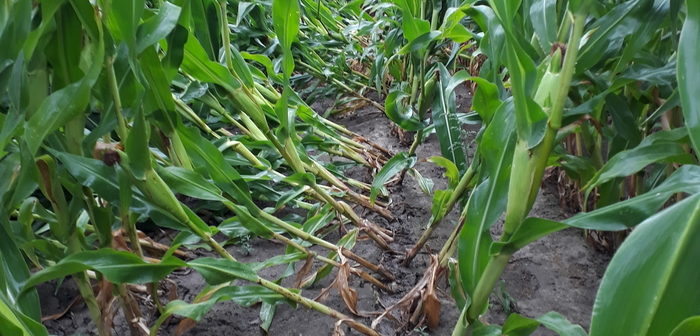With some farmers reporting lodging in maize crops, Limagrain Forage technical manager Richard Camplin says the increased incidence is a consequence of the season.
“While some varieties are more prone than others, lodging in maize is fortunately a reasonably rare occurrence,” he explains. “This year it seems to be more of a problem with varieties, usually resistant to lodging, being affected.”
Mr Camplin says that the increased incidence of lodging is due to the combination of the wet spring and warm summer and the subsequent impact on plant development. In particular, the root:plant ratio and how this changes through the season, the root depth and extent of the development of buttress roots all play a very major role in a plants susceptibility to lodging.
He explains that this year, drilling generally occurred in wet conditions, where moisture was more than adequate. This meant root systems were ‘lazy’, not having to search for moisture. Then, with rapidly warming temperatures, plant growth accelerated, while root development in the drying soils didn’t keep pace leading to fewer of the crucial structural roots.
“In some areas with light soils, plants soon ran out of water, leading to very short stunted crops. On heavier ground, where water was not limited so early, plants could grow on well. But as these soils dried out, so the crops had to rely on the onset of heavy showers to wet the upper surface of the soil as this is where the roots were located
“The result is that there are some very big crops with poorly developed root systems and very few buttress roots. Plant growth has out-stripped root growth, leaving an abnormally large plant:root ratio.”
He says that after the prolonged period of dry weather, many areas had strong winds and heavy rain, which played a big part in pushing over very big plants with poor root systems.
“The danger now is that if crops are left too long in the field, lodging could become more commonplace as plants begin to senesce and we see more wet and windy conditions. Farmers need to monitor crop maturity closely and make sure they are harvesting as soon as crops achieve the optimum 32%DM. Don’t leave it too late and increase the risk of crops going flat.
“Where crops do suffer, we would advise discussing the best approach to harvesting with your contractor,” Mr Camplin concludes




